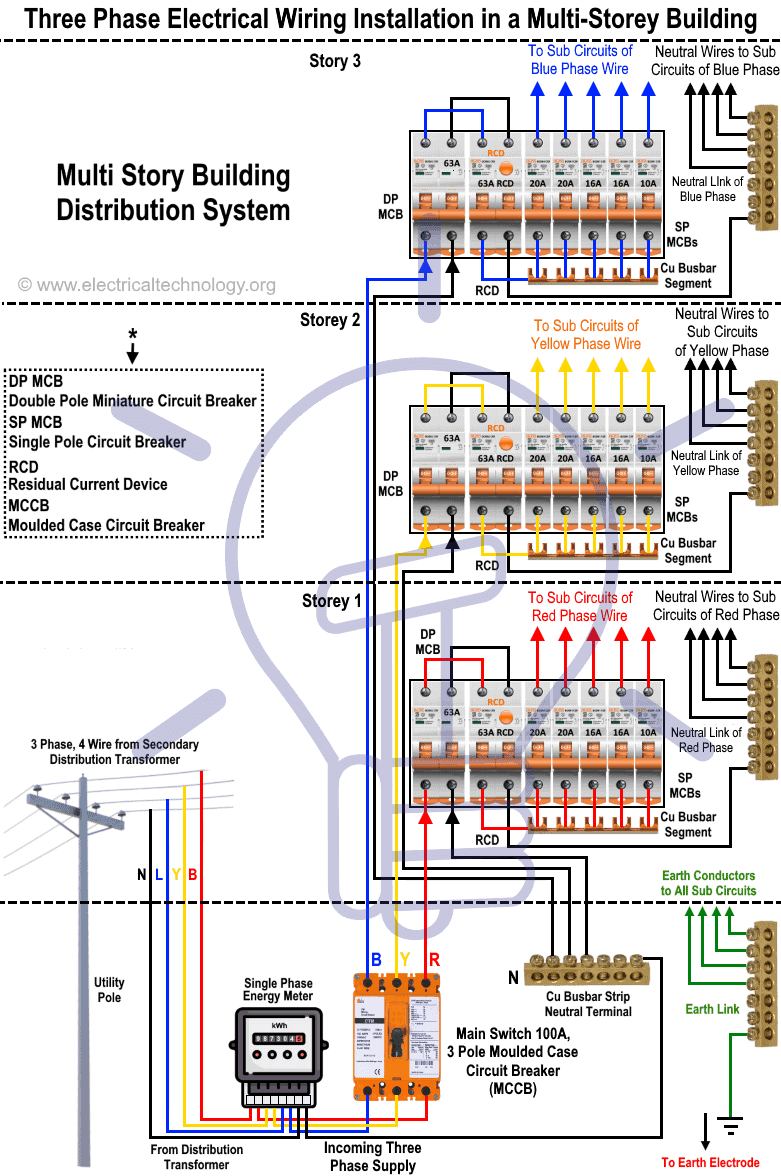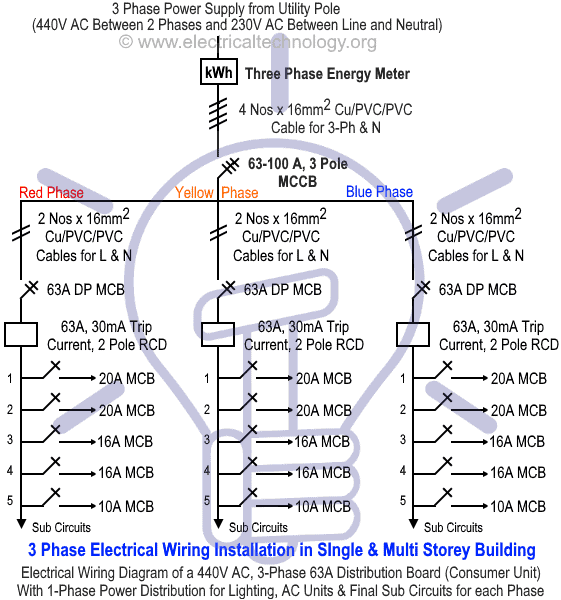Three Phase Electrical Wiring Installation in a Multi-Story Building
3-Phase & 1-Phase Electrical Distribution Wiring Installation in a Multistory Building
In today electrical wiring installation tutorial, we will show how to wire a Three Phase Consumer Unit Installation in a multi-storey building from Utility Pole to a 3-Phase Energy Meter & 3-Phase Distribution board and then How to connect Single Phase & Three Phase Loads in a Three Phase Wiring Distribution System in home electric supply system.
In our previous posts, We did it for Single Phase & Three Phase electrical wiring installation in home and already know that what are Three Phase Power, Why and when we need it? as well as MDB, DB, Final Sub Circuit, MCB, MCCB, CB and RCD etc. So we will have to go strait forward to the point as. Now lets begin.
Related Wiring Tutorials:
- Three Phase Electrical Wiring Installation in Home – NEC & IEC
- Single-Phase Electrical Wiring installation in a Multi-Story Building
Requirements for Three Phase Wring Installation in Multistory Building
In this tutorial, we need the following wiring accessories to wire three phase power in home.
- Three Phase Energy meter = 1 No
- Three Pole MCCB, 63A = 1 No
- Double Pole, 63A, 30mA Trip Current RCD = 3 Nos
- Double Pole MCBs, 63A = 3 Nos
- Single Pole, 20A, MCB = 6 Nos
- Single Pole, 16A, MCB = 3 Nos
- Single Pole, 10A, MCB = 6 Nos
- Distribution board cases = 3 Nos
- Bus bar Link for Neutral Cable Connections
- Copper strips for MCB common connection = 3 Nos (Cu Busbar segment)
- Copper strip Busbar for Earth & Ground Link
Related Post: Different Types of Electrical Wiring Systems and Methods of Electrical Wiring Installation
How to Wire There Phase Main Distribution Board in Multistory Building?
We have shown the basic electrical wiring of bulb, fans etc (i.e. Sub-circuits and final sub circuits) in our previous posts, so follow the steps below to do the same as mention below..
To do electric distribution system in a multi-storey building, follow the following steps.
- First of all, connect the three-phase energy meter as shown in fig. ( if you aren’t sure that how to wire a three-phase energy meter, then check this simple tutorial which show How to wire a Three-Phase Energy Meter?
- Connect the Moulded Case circuit Breaker (MCCB) as main switch to the incoming three phases (R, Y, B) from three-phase energy meter. (Check the wiring color code for IEC and NEC in below section)
- Now connect the outgoing three phases (R, Y, B) from moulded case circuit breaker (MCCB) to the double pole (DP) MCB , RCD, SP (Single Pole MCBs and load) as shown in fig)
- Now connect the RCD from DP with Phase (Line) and Related Neutral Link. The Out going Phase lines should be connected to the final circuits and final sub circuits. The same can be done for Neutral Wires.
- Finally, Connect the electrical devices and appliances with the Earth link terminal which leads to earth electrode in the earthing and grounding system as shown in fig.
- Do the the same steps for all three distribution boards in different storey (Three storeys in our case).
Keep in mind that you have to use the main breaker with proper rating i.e. which carry the total load current of all distribution boards of each storey and use the breaker in sub distribution board according to the load of that desired storey i.e. fans, lights etc in single storey and so on for other storeys. Also, You may use a 4-Pole MCCB instead of 3-Pole MCCB as the last 4th slot can be used to connected the Neutral Wire (Check the diagram and brochure for proper guidance).
Also, use separate main breaker for each storey and then distribute wiring in additional three or four main circuits in different sections. If you directly connect the over all load of different storys to the main breaker instead of separate main board, all the connected load (bulbs, fans etc) would disconnect in the whole building at once in case of tripping any circuit due to some reason (short circuit etc) which leads to trip the main switch.
In addition, In case of single circuit instead of three circuits, if the load of a single storey increases, the more current will have to flow and cables may be overheated. Also, voltage drop would be increased so the rated voltage may not reach to the electrical appliances. In that case, the connected light bulbs would be dimmer and other appliances may not work properly. Moreover, there is a risk of electric fire and hazard in the building due to overheated cables.
Click image to enlarge

Electrical Wiring Color Codes of IEC and NEC
Wiring Color Code: We have used Red for Live or Phase , Black for Neutral and Green for Earth Wire. You may use the specific area codes i.e. IEC – International Electrotechnical Commission (UK, EU etc) or NEC (National Electrical Code [US & Canada] where; NEC: Single Phase 120V AC: Black = Phase or Line, White = Neutral and Green/Yellow = Earth Conductor Three Phase 208 AC: Black = Phase 1 or Line1, Red = Line 2, Blue = Line 3, White / Gray = Neutral and Green/Yellow = Earth Conductor IEC: Single Phase 230V AC: Brown = Phase or Line, Blue = Neutral and Green = Earth Conductor Three Phase 208 AC: Grey= Phase 1 or Line1, Black = Line 2, Brown = Line 3, Blue = Neutral and Green= Earth Conductor
- Related Post: Staircase Wiring Circuit Diagram – How to Control a Lamp from 2 Places by 2-Way Switches?
Wiring Diagram of Three Phase Distribution Board In Multi-Storey Building

Good to Know
In a Three Phase Wiring Distribution System (Star Connection i.e. 3 Phase, 4 Wire System);
Line to Line Voltage = 415V AC (208V in US)
Line to Neutral Voltage = 230V (120V in US)
I.e.
- L1 to L2= 440 V
- L2 to L3= 440 V
- L3 to L1= 440 V
And
- L1 to N = 230 V
- L2 to N = 230 V
- L3 to N = 230 V
in USA and other Countries
- L1 to L2= 208V
- L2 to L3= 208V
- L3 to L1= 208V
And
- L1 to N = 120V
- L2 to N = 120V
- L3 to N = 120V
Related Post: How to Connect a Portable Generator to Home Supply System (Three Methods)
General Precautions
- Electricity is Our Enemy, if you give it a chance to kill you, Remember, they will never miss it. Please read all caution and instruction while doing this tutorial in practical.
- Disconnect the power source before servicing, repairing or installing electrical equipments.
- Ue the proper cable in size with this simple calculation method ( How to determine the suitable size of cable for Electrical Wiring Installation)
- Never try to work on electricity without proper guidance and care.
- Work with electricity only in presence of those persons who has good knowledge and practical work and experience who know how to deal with electricity.
- Read all the instruction and cautions and follow them strictly.
- Doing your own electrical work is dangerous as well as illegal in some areas.Contact the licensed electrician or the power supply company before practicing any change in electrical wiring connection.
- The author will not be liable for any losses, injuries, or damages from the display or use of this information or if you try any circuit in wrong format. So please! Be careful because it’s all about electricity and electricity is too dangerous.
You may also check the related Electrical Wiring Installation Tutorials.







thanksssss for this information.keep it up
Thanks for appreciation
can we get 400V supply by using two phases while those two phases are also taken for 230V supply. Thank you
from my analysis i can see the 1st storey is supplied by the red line the 2nd storey being the yellow phase and finally the 3rd being the blue line for instance if i have more than 3 storey which can add up to about 10 or more how would i manage to power the other storey..please illustrate to me with a diagram if its possible
thank you
Dear Wasim Bhai,
here in India, in a 3 Storied building, in each floor we have number of houses i.e. 4Nos, and we have individual EB Meter for each house and not a single EB Meter for entire Floor. Now how does it works can you Explain it though diagram, I will be very helpful if you do so.
i also same doubt.. if u know please let me know
i also same doubt.. if u know please let me know
Use cut out fuse for every storey at the distribution board that would take the hot wire there thanks
how to calculate of power of a particular phase in a three phase system…
each phase separately…
can we consider 440v in each phase…
like..P=VI cos
P=440*I*0.8
in a 3 phase, P = √3 x VL x IL x cosΦ
Or P = √3 x Vph x Iph x cosΦ
For each Phase, the power would be:
P = Vph x Iph x cosΦ … (For a single Phase in three phase system)
Dear Engineer Waseem
what sofware you are using for mcb electrical designe and drawing?
dear sir
how we will select breaker rating and cable size as per as load.
if there is any formula pls illustrate me and reply.
dear sir
if the load of each floor is not same .and building is more than 3 storey. then how we do wiring
send me the cost of lighting and heating circuits of multi storey say 5 floor…
Suppose the building has 5 stories, how we will distribute 3 three phase in the building stories and what about the load balance?